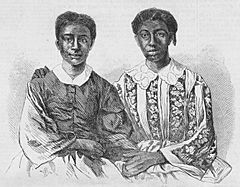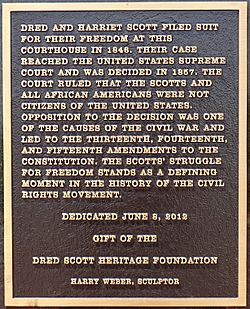Dred Scott facts for kids
Quick facts for kids
Dred Scott
|
|
|---|---|
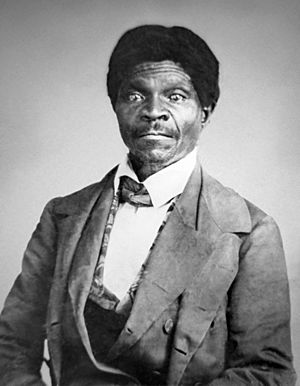
Scott c. 1857
|
|
| Born | c. 1799 |
| Died | September 17, 1858 (aged approximately 59) St. Louis, Missouri, U.S.
|
| Resting place | Calvary Cemetery |
| Known for | Dred Scott v. Sandford |
| Spouse(s) | |
| Children | 4 (2 died during infancy) |
Dred Scott (born around 1799 – died September 17, 1858) was an enslaved man in the U.S.. He became famous for trying to win his freedom through the legal system. His case, known as Dred Scott v. Sandford, went all the way to the Supreme Court.
Sadly, the Supreme Court ruled against him. This decision made many people angry. It also made the issue of slavery much bigger, leading to the American Civil War a few years later. Slavery was finally ended in the U.S. after the war.
Contents
The Life of Dred Scott
Dred Scott was born into slavery around 1799 in Southampton County, Virginia. We don't know if "Dred" was his real name or a shorter version of another name.
In 1818, Dred was taken by the Blow family and their other enslaved people to Alabama. They tried to run a farm near Huntsville, but it didn't work out. This area is now where Oakwood University is located.
The Blow family stopped farming in 1830. They moved to St. Louis, Missouri, where they opened a boarding house. Dred Scott was then sold to Dr. John Emerson. Dr. Emerson was a surgeon in the United States Army.
Dr. Emerson moved often because of his army job. He took Scott with him to each new place. In 1836, they went to Fort Armstrong in Illinois, which was a free state. This meant slavery was not allowed there.
In 1837, Dr. Emerson took Scott to Fort Snelling. This fort was in what is now Minnesota. At that time, it was part of the free Wisconsin Territory. While at Fort Snelling, Scott met and married Harriet Robinson. She was also an enslaved person. Their marriage was a civil ceremony, which was unusual for enslaved people.
Dr. Emerson was later sent to Louisiana. He left the Scotts behind at Fort Snelling. He rented them out to other army officers. In 1838, Dr. Emerson married Eliza Irene Sanford. He then sent for the Scotts to join him.
While traveling north on a steamboat, Harriet Scott gave birth to their first child, Eliza. They later had another daughter named Lizzie. They also had two sons, but they died when they were very young.
The Emersons and Scotts returned to Missouri in 1840. Missouri was a slave state. Dr. Emerson left the army in 1842. He died in 1843. His wife, Irene, inherited his property, including the Scotts. For three years, she continued to rent out the Scotts to others.
In 1846, Dred Scott tried to buy his family's freedom. He offered $300, which was a lot of money back then. But Irene Emerson said no. So, Dred and Harriet each filed lawsuits to try and win their freedom. Their cases were later combined into one.
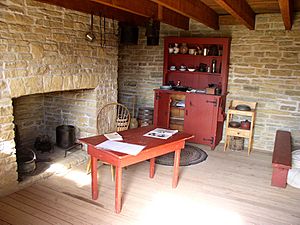
Dred Scott v. Sandford: The Big Court Case
What the Case Was About
The Scotts' cases first went to a court in Missouri. The first court decided that because the Scotts had lived in a free territory with their owner, they should be free. This was based on a rule called "once free, always free."
However, Irene Emerson appealed this decision. In 1852, the Missouri Supreme Court overturned the ruling. They said Missouri didn't have to follow the laws of free states. They also said Scott should have sued for freedom while he was still in the Wisconsin Territory.
Scott then took his case to a federal court. Eventually, it reached the highest court in the country: the U.S. Supreme Court. In 1857, the Supreme Court made a very important and controversial decision. They ruled that people of African descent, whether enslaved or free, were not U.S. citizens. This meant they could not sue in federal court.
The Court also ruled that the Missouri Compromise was unconstitutional. The Missouri Compromise was a law that had tried to balance slave and free states. The Supreme Court's decision was a major setback for enslaved people and their supporters.
Help for Scott's Case
Dred Scott's legal fight was supported by Peter Blow's children. The Blow family had owned Dred Scott before Dr. Emerson. Over time, they had become against slavery. They helped pay for Scott's legal costs.
Henry Taylor Blow, one of Peter Blow's sons, later became a Republican Congressman. Other Blow family members also helped. They made sure Scott had good lawyers. While the case was ongoing, Scott was rented out for work. The money he earned was kept safe for his legal fees.
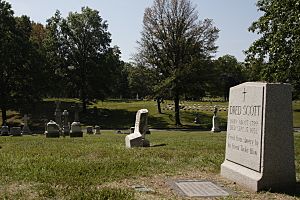
In 1851, Scott worked as a janitor in a law office. One of the lawyers there, Roswell Field, agreed to represent Scott for free in the federal courts. Later, Montgomery Blair argued Scott's case before the U.S. Supreme Court. Blair later worked for President Abraham Lincoln.
In 1850, Irene Emerson remarried and moved to Springfield, Massachusetts. Her new husband, Calvin C. Chaffee, was an abolitionist. He was elected to Congress in 1854. Some newspapers criticized him for owning enslaved people, even though he was an abolitionist. Chaffee said he and his wife didn't know about the case until it was already in court. He asked if his wife could free the Scott family.
Some people wondered if the case was planned as a "test case." This means a case specifically designed to get a ruling on a big legal question. Both sides, those against slavery and those for it, had their suspicions.
Later, a historian found that John Sanford, the person named in the case, never actually owned Dred Scott. But Sanford had been involved in defending Mrs. Emerson in the original lawsuit.
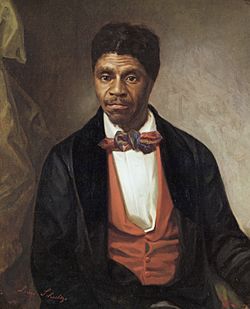
Freedom After the Case
After the Supreme Court's ruling, the Chaffees gave the Scott family to Henry Taylor Blow. On May 26, 1857, Taylor Blow officially freed Dred Scott and his family.
Dred Scott then worked as a porter in a St. Louis hotel. But his freedom did not last long. He died from tuberculosis in September 1858, about a year after gaining his freedom. He was survived by his wife, Harriet, and their two daughters.
Dred Scott was first buried in Wesleyan Cemetery in St. Louis. Nine years later, the cemetery closed. Taylor Blow moved Scott's coffin to an unmarked grave in the nearby Catholic Calvary Cemetery. This cemetery allowed enslaved people to be buried there if their owners were Catholic. Today, people sometimes place Lincoln pennies on Scott's gravestone for good luck.
Harriet Scott was buried in Greenwood Cemetery. She lived 18 years longer than her husband, dying on June 17, 1876. Their daughter, Eliza, married and had two sons. Her sister Lizzie never married. After Eliza died young, Lizzie helped raise her nephews. One of Eliza's sons died young, but the other married and had children. Some of Dred Scott's descendants still live in St. Louis today.
See also
 In Spanish: Dred Scott para niños
In Spanish: Dred Scott para niños



